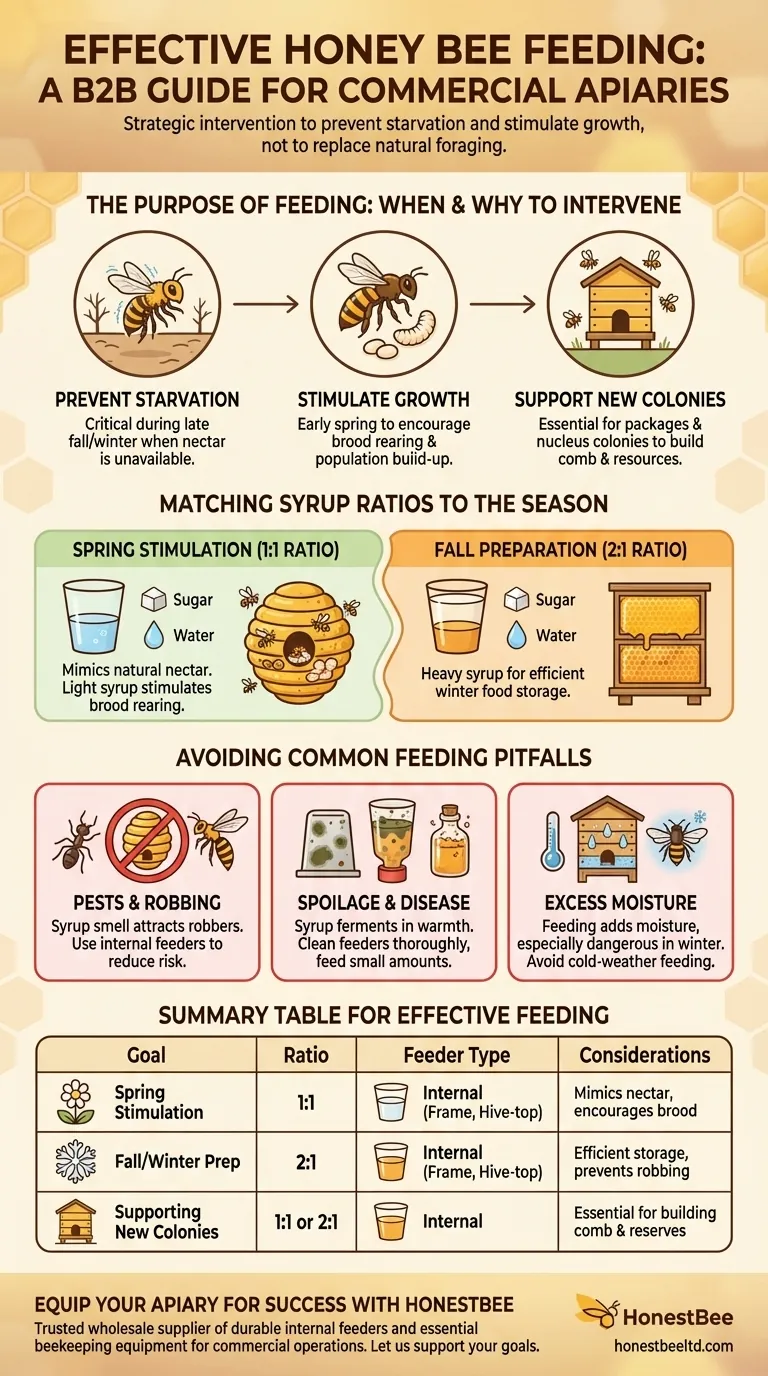To feed honey bees effectively, you must match the sugar syrup ratio to the season's goal, keep feeders meticulously clean to prevent spoilage, and place them strategically to minimize robbing and pest pressure. You should use a 1:1 sugar-to-water ratio for spring stimulation and a 2:1 ratio for fall storage, only feeding when natural nectar is scarce.
The goal of supplemental feeding is to strategically intervene to prevent starvation or stimulate growth, not to replace the natural foraging cycle. Effective feeding supports the hive’s health without introducing new problems like pests, disease, or excess moisture.

The Purpose of Feeding: When and Why to Intervene
Honey bee feeders are a critical management tool, but they should be used with a clear purpose. Feeding is an intervention for specific circumstances, not a routine task.
To Prevent Starvation
The most critical reason to feed is to prevent a colony from starving. This is most common during late fall, winter, and early spring when natural nectar sources are unavailable.
To Stimulate Colony Growth
In early spring, a light syrup can simulate a natural nectar flow. This encourages the queen to begin laying eggs and helps the colony build its population in time for the main honey flow.
To Support New Colonies
Newly installed packages, swarms, or nucleus colonies have no stored food reserves. Feeding is essential to help them draw out comb and build up the resources needed to survive their first season.
Matching Syrup Ratios to the Season
The concentration of your sugar syrup sends different signals to the bees. Mixing the correct ratio is fundamental to achieving your goal.
The 1:1 Ratio for Spring
A syrup made with one part sugar to one part water by weight or volume closely mimics natural nectar. This light syrup is easy for bees to consume and process, stimulating brood rearing and colony expansion.
The 2:1 Ratio for Fall
A syrup made with two parts sugar to one part water is a heavy syrup. Its density makes it more efficient for bees to store as winter food, requiring them to expend less energy evaporating excess water.
Understanding the Trade-offs: Common Feeding Pitfalls
While necessary at times, feeding introduces risks that can harm the very colony you are trying to help. Awareness is the key to prevention.
Attracting Pests and Robbing
The smell of sugar syrup can attract ants, wasps, and bees from other hives, inciting a "robbing" frenzy that can overwhelm and destroy a weaker colony. Internal feeders, like frame or hive-top feeders, dramatically reduce this risk.
Risk of Spoilage and Disease
Sugar syrup can ferment or grow mold, especially in warm weather. This can make your bees sick. Never feed more than the bees can consume in a few days and clean feeders thoroughly with hot water between refills.
Creating Excess Hive Moisture
Feeding adds a significant amount of water to the hive environment. This is especially dangerous during the cold winter months when excess moisture can lead to chilled brood and disease. Stop feeding once natural nectar is available.
Making the Right Choice for Your Goal
Your feeding strategy should always be dictated by a specific objective. By aligning your method with your goal, you ensure the intervention is helpful, not harmful.
- If your primary focus is stimulating spring growth: Use a 1:1 syrup ratio in an internal feeder to encourage brood rearing without attracting robbers.
- If your primary focus is preparing the hive for winter: Use a 2:1 syrup ratio to help bees quickly build up their winter food stores.
- If your primary focus is minimizing pests and robbing: Always choose an internal feeder and be vigilant about cleaning up any spills immediately.
By applying these principles, you can confidently use feeders as a precise tool to support, not disrupt, your colony's health and resilience.
Summary Table:
| Goal | Syrup Ratio (Sugar:Water) | Best Feeder Type | Key Considerations |
|---|---|---|---|
| Spring Stimulation | 1:1 | Internal (e.g., frame, hive-top) | Mimics nectar flow, encourages brood rearing |
| Fall/Winter Preparation | 2:1 | Internal (e.g., frame, hive-top) | Efficient for food storage, prevents robbing |
| Supporting New Colonies | 1:1 or 2:1 (as needed) | Internal | Essential for building comb & food reserves |
Equip your apiary for success with HONESTBEE.
Effective feeding is just one part of a successful beekeeping operation. As a trusted wholesale supplier of beekeeping supplies and equipment for commercial apiaries and distributors, HONESTBEE provides the durable, reliable tools you need—from high-quality internal feeders to essential hive components.
Let us help you build a more resilient and productive operation. Contact our team today to discuss your wholesale needs and discover how our products can support your goals.
Visual Guide

Related Products
- Rapid Bee Feeder White Plastic 2L Round Top Feeder for 8 or 10-Frame Bee Hives
- HONESTBEE Professional Hive Top Bee Feeder Feeding Solution
- HONESTBEE Entrance Bee Feeder Professional Hive Nutrition Solution for Beekeeping
- Classic Boardman Entrance Bee Feeder Hive Front Feeding Solution
- HONESTBEE Round Hive Top Bee Feeder for Syrup
People Also Ask
- Do beekeepers leave honey for bees? The Essential Guide to Sustainable Hive Management
- How much honey does a strong hive need to survive winter? Ensure Your Colony's Survival (60-80 lbs)
- What is the best thing to feed bees? A Guide to Supplemental Feeding for a Thriving Hive
- Can sugar syrup contaminate the honey crop? A Beekeeper's Guide to Protecting Honey Purity
- What is the capacity of the round hive top feeder for syrup and pollen? A Guide to Targeted Apiary Support



















